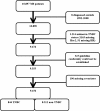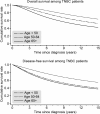Adherence to treatment guidelines and survival in triple-negative breast cancer: a retrospective multi-center cohort study with 9,156 patients
- PMID: 24138748
- PMCID: PMC3815231
- DOI: 10.1186/1471-2407-13-487
Adherence to treatment guidelines and survival in triple-negative breast cancer: a retrospective multi-center cohort study with 9,156 patients
Abstract
Background: Triple-negative breast cancer (TNBC) remains a challenging topic for clinical oncologists. This study sought to evaluate TNBC versus other breast cancer subtypes with respect to survival parameters. We evaluated possible differences in survival in TNBC by age and by the extent to which evidence-based treatment guidelines were adhered.
Methods: This German retrospective multi-center cohort study included 9156 patients with primary breast cancer recruited from 1992 to 2008.
Results: The rates of guideline adherence are significantly lower in TNBC compared to non-TNBC subtypes. These lower rates of guideline adherence can be observed in all age groups and are most pronounced in the >65 subgroup [<50 (20.9% vs. 42.0%), 50-64 (25.1% vs. 51.1%), and >65 (38.4% vs. 74.6%)]. In TNBC patients of all age groups, disease-free survival and overall survival were associated with an improvement by 100% guideline-adherent adjuvant treatment compared to non-adherence. Furthermore, TNBC patients of all ages had similar outcome parameters if 100% guideline-adherent adjuvant treatment was applied.
Conclusion: The rates of guideline-adherent treatment were significantly lower in TNBC, even though guideline adherence was strongly associated with improved survival. In the case of 100% guideline-adherent treatment, no difference in survival was observed over all the age groups examined, even in the group of >65-year-old TNBC patients.
Figures





Similar articles
-
Triple-negative breast cancer: the impact of guideline-adherent adjuvant treatment on survival--a retrospective multi-centre cohort study.Breast Cancer Res Treat. 2012 Apr;132(3):1073-80. doi: 10.1007/s10549-011-1935-y. Epub 2011 Dec 29. Breast Cancer Res Treat. 2012. PMID: 22205141
-
Receipt of guideline-concordant care and survival among young adult women with non-metastatic breast cancer.Breast Cancer Res Treat. 2025 Apr;210(2):347-354. doi: 10.1007/s10549-024-07570-w. Epub 2024 Dec 9. Breast Cancer Res Treat. 2025. PMID: 39652290 Free PMC article.
-
Adjuvant chemotherapy in pT1ab node-negative triple-negative breast carcinomas: Results of a national multi-institutional retrospective study.Eur J Cancer. 2017 Oct;84:34-43. doi: 10.1016/j.ejca.2017.06.043. Epub 2017 Aug 4. Eur J Cancer. 2017. PMID: 28780480
-
Prognosis in different subtypes of metaplastic breast cancer: a population-based analysis.Breast Cancer Res Treat. 2019 Jan;173(2):329-341. doi: 10.1007/s10549-018-5005-6. Epub 2018 Oct 19. Breast Cancer Res Treat. 2019. PMID: 30341462
-
Metaplastic Carcinoma of the Breast Is More Aggressive Than Triple-negative Breast Cancer: A Study From a Single Institution and Review of Literature.Clin Breast Cancer. 2017 Aug;17(5):382-391. doi: 10.1016/j.clbc.2017.04.009. Epub 2017 Apr 26. Clin Breast Cancer. 2017. PMID: 28529029 Free PMC article. Review.
Cited by
-
Guideline conformity treatment in young women with early-onset breast cancer in Germany.Breast Care (Basel). 2014 Oct;9(5):349-54. doi: 10.1159/000366435. Breast Care (Basel). 2014. PMID: 25759616 Free PMC article.
-
Nomogram for predicting the risk of bone metastasis in breast cancer: a SEER population-based study.Transl Cancer Res. 2020 Nov;9(11):6710-6719. doi: 10.21037/tcr-20-2379. Transl Cancer Res. 2020. PMID: 35117281 Free PMC article.
-
Impact of Guideline-Discordant Treatment on Cost and Health Care Utilization in Older Adults with Early-Stage Breast Cancer.Oncologist. 2019 Jan;24(1):31-37. doi: 10.1634/theoncologist.2018-0076. Epub 2018 Aug 17. Oncologist. 2019. PMID: 30120157 Free PMC article.
-
Prevalence of Cardiac Disease in Breast Cancer Patients at Time of Diagnosis Compared to the General Female Population in Germany.Breast Care (Basel). 2018 Aug;13(4):264-271. doi: 10.1159/000487261. Epub 2018 Mar 29. Breast Care (Basel). 2018. PMID: 30319328 Free PMC article.
-
Cancer-Testis Antigens in Triple-Negative Breast Cancer: Role and Potential Utility in Clinical Practice.Cancers (Basel). 2021 Jul 31;13(15):3875. doi: 10.3390/cancers13153875. Cancers (Basel). 2021. PMID: 34359776 Free PMC article. Review.
References
-
- Badve S, Dabbs DJ, Schnitt SJ, Baehner SL, Decker T, Eusebi V, Fox SB, Ichihara S, Jacquemier J, Lakhani SR, Palacios J, Rakha EA, Richardson AL, Schmitt FC, Tan PH, Tse GM, Weigelt B, Ellis IO, Reis-Filho JS. Basal-like and triple-negative breast cancers: a critical review with an emphasis on the implications for pathologists and oncologists. Mod Pathol. 2011;24(2):157–167. doi: 10.1038/modpathol.2010.200. - DOI - PubMed
Publication types
MeSH terms
LinkOut - more resources
Full Text Sources
Other Literature Sources

